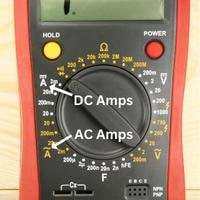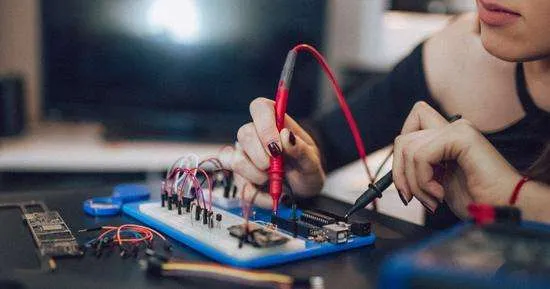Measuring amperage is a measurement of the amount of current flowing through a circuit. Sometimes, it’s necessary to check if an electrical appliance uses more current than it usually does. The main question is: “Can you measure amps with a multimeter?”
Yes, you can, but you must be experienced for safety reasons. Electricity is not something to play around with, nor does a person become an expert by googling “How to measure amps with a multimeter?”
Let’s discover this in detail:
Table of Contents
ToggleAmps symbol on multimeter
There are multiple settings on the rotary dial of the multimeter, but we’ll select the amps(A), milliamp(mA), or microamp(µA) settings to measure current(amps). The amps symbol on the multimeter is “A.” Whether labeled as a capital “A” or “10A”, the SI unit of the ampere is A.
You can also measure current in ampere subunits (less than 1 ampere), such as mA (milliamp) and µA (microamps). Milliamp is the thousand part (1/1000) of an ampere, and microamp is the millionth part (1/1000000) of an ampere.
You should also know that there are two types of amps settings on your multimeter, DC amps(A⎓) and AC amps (A〜).
Selecting an amp range(milliamp, microamp) on the multimeter is essential. For example, if your fridge uses 3 to 5 amps, then the multimeter should have a range of 10 amps. If the current exceeds the capacity of a multimeter, it might blow its fuse.
How to measure amps with a multimeter
- To measure current with a multimeter, set DC (A⎓)or AC(A〜)amps settings.
- Adjust an ampere range (A, mA, µA) above the circuit you are testing.
- Connect the red probe to the live (positive) and the black probe to the ground (negative) wire.
- Check the amp reading on display.
Follow a detailed step-by-step guide for easy understanding:
-
Multimeter’s Basics
A multimeter consists of four input jacks and a rotary dial. The main input jacks are the amps and the milliamp/micro amp terminal. This milliamp/microamp port is next to the amps port and is marked with “mA.”
We insert the red probe in the mA(milliamps) labeled port to measure less than an ampere current. For higher current measurements, such as 1-10 amps, we insert the red probe in the 10A labeled port.
-
Safety Precautions

This is repeated, but you must be well-equipped to handle dangerous situations.
Be aware of water or bare wires; don’t touch wires without wearing gloves or protection. Not many people consider this warning, but carelessness leads to electric shocks.
If you have alligator clips, you can use them on a multimeter to hold the wires of a circuit you are testing, freeing up your hands. However, both types of probes will connect to the meter similarly.
-

Multimeter Setting
select AC (A〜) sign if you are testing an AC amps circuit. AC current is used to run home appliances, coming through transformers.
If you are measuring current from a DC source such as a battery, set your multimeter to DC amps with the symbol “A⎓, “
Your multimeter should have a red probe and a black probe. The black probe (-ve) goes into the “COM” port on the multimeter.
Insert the red probe( +ve) in the amps port (if the circuit is above ) instead of the milliamps/microamps port. As the name suggests, the milliamps/microamps port is for current lower than the amps port.
It’s also important to know the amperage of a circuit you are testing, not to test a circuit higher than the multimeter range.
It might cause the fuse to blow and will not give you proper readings. If you want to use a lower current circuit, use the milliamp/micro amp terminal.
-
Connect probes to the circuit
The current should move into the red probe and leave the black probe. This is important because the multimeter should be a part of the circuit.
Connect the multimeter’s red (positive) probe to the positive wire (live) of the circuit and the black probe to the negative wire (ground).
If you are testing the amperage of a battery-based circuit, connect the red probe to the wire facing the positive battery terminal and the black probe to the wire connected to the negative battery terminal.
You must be very careful when connecting the multimeter to the circuit. First, turn the circuit off, then connect the multimeter to the desired circuit. This step is also called “Breaking the circuit.”
-
Check multimeter reading
You will now get the reading on the multimeter. Keep in mind that if the scale gives a reading between 1 and 10, it is in amps “A.” And if the measurement has a decimal point, then it is milliamps.
You must hold the probes in place for a minute or two to get precise readings. Though it is unnecessary, you can change the setting to milliamps if the readings are not precise in amps.
Frequently Asked Questions
How to test amps on a 12V battery?
- As a battery is a DC power source, set your multimeter dial to the DC amp setting with symbol A⎓.
- Set a higher amp range on your multimeter than the battery. Such as, if the battery is labeled with 20 milliamps, set the multimeter above 20 milliamps, such as 100 mA.
- Attach your multimeter’s red probes (positive) to the battery’s positive terminal and black probe (negative) to the negative battery terminal.
How to measure amps with a clamp multimeter?
- To measure current with a clamp multimeter, turn the dial to DC or AC setting.
- Before taking a measurement, wait for the display to be stable.
- Press the zero button for an accurate reading.
- Open the jaws and insert a wire or conductor to measure amperage.
- Check the reading on the multimeter display.
How to measure amps with a multimeter car battery
- Set your multimeter to DC amps(A⎓).
- Adjust the dial to the ampere range (20mA, 200mA) above the battery.
- Connect the red probe to the positive battery terminal and the black probe to the negative battery terminal.
- Check the reading on the multimeter display.
How to check amps with a Klein multimeter
In Klein multimeters, you have to adjust the ampere range below the A⎓〜 sign, such as (10A, mA or µA), and the multimeter will measure both AC and DC. You don’t have to adjust your multimeter to DC (A⎓) or AC(A〜) amps separately, like other multimeters.
Connect the red probe to the positive wire (live) or battery terminal of a circuit and the black probe to the ground wire or negative battery terminal. The multimeter will display an amperage on the multimeter.
Conclusion
Sometimes it’s quite necessary to test an appliance’s current flow (amp) or a circuit. A multimeter is an excellent cheap device that you can use as a beginner in DIY. Select the AC amp (A〜) setting, connect probes to a circuit, and get a reading on the multimeter screen.
Follow the instructions in the guide to test the amperage of any circuit safely.
Related Guide:





